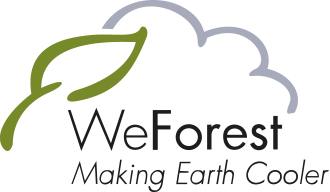
Our collaboration in the Atlantic Forest with AES Brasil is restoring the forest on the edges of the Tietê river and its tributaries with native species, protecting the water from soil siltation and runoff from herbicides and pesticides.
Our project here is well on track, with the 2022/2023 planting season placing 86 more hectares of riparian (riverside) areas under restoration by the end of March 2023. The 2023/2024 planting season has already concluded, too: the restoration of 52.6 hectares (79 582 trees) was finished in February 2024. Altogether, this brings the project to a total of 376 ha since the start.
Maintenance is being carried out as planned, keeping invasive grasses under control during the hot and rainy season, a critical period when they can outcompete the recently planted tree seedlings and jeopardize survival and development of the restored sites.
A special achievement in 2023 was the first harvests from the agroforestry systems we already established over 12.2 ha of private properties in 2022. We couldn’t have achieved this without bringing in partners COPROCAM and Nace-PTECA to provide valuable agroforestry training and support.
A major focus this year was capacity building, with WeForest playing a large role in knowledge exchange and dissemination, aiming to improve technical capacity and project quality. A cross-project field workshop between the Pontal project and our other Atlantic Forest project in Tietê, both part of our Wildlife Corridors Programme, toured the restoration sites and looked at similarities and differences between the project, sharing tips and best practices.
Another highlight was the presentation of the project at the World Conference on Ecosystem Restoration, organized by the International Society for Ecological Restoration (SER), which took place in Australia in September.
*Final count pending
The 2022/2023 planting season ended in March 2023, and of the total of 100 ha restored, 86 ha was native forest both along the Tietê river and in some riparian areas in Dandara Rural settlement. Around 160 000 tree seedlings of 80 native tree species (29 filling spp; 51 diversity spp) were planted. The remaining 14 ha was or will be planted for agroforestry (see Livelihoods, below).
In the planting season 2023/2024, which just finished in February 2024, we restored 52.6 ha of riparian areas with 79 582 tree seedlings of 81 native tree species. Defining the next areas of land for restoration will be done in August 2024, and planting will start in November or December 2024, depending on the rain.
We were delighted to receive some amazing drone photos in early 2024 of some very lush-looking restoration areas! Most were planted in 2022, and are doing incredibly well just a couple of years later. Move the handles on the images below to see before and then after. The yellow-flowered trees that you can see in several of the sites are canafístula (Peltophorum dubium); the individuals shown here were not part of the planting, as they were already there. But we do plant this species as well.
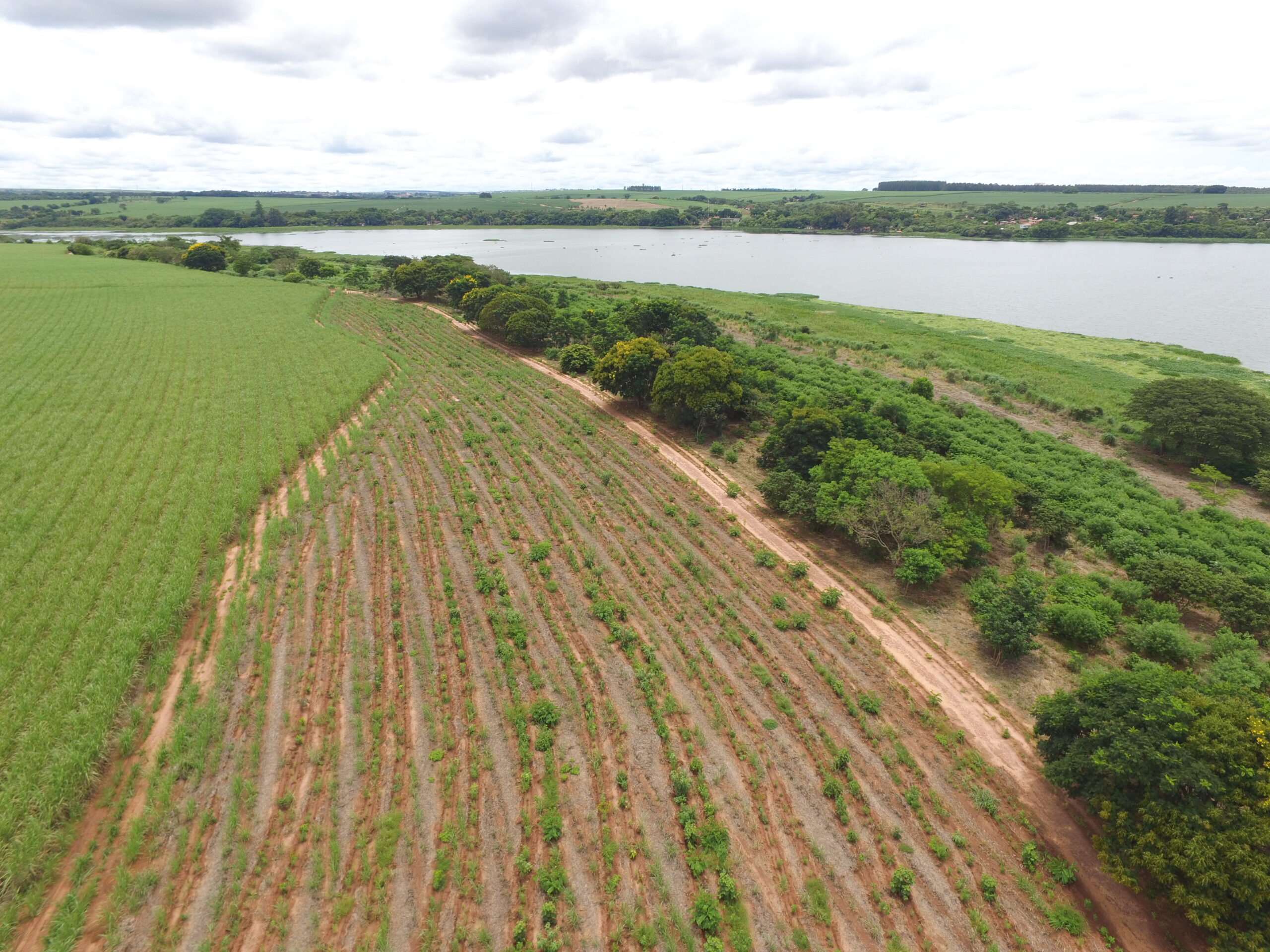
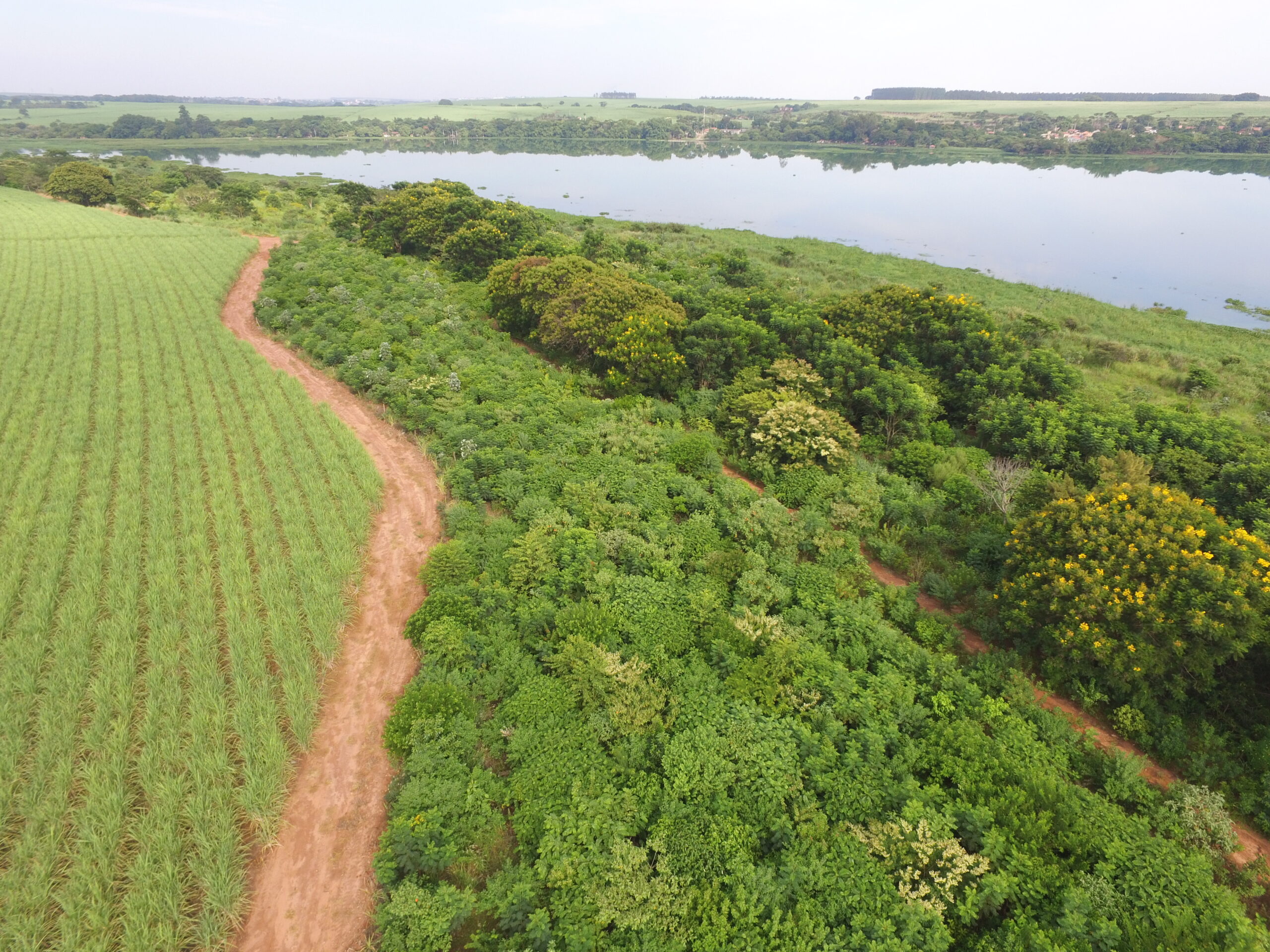

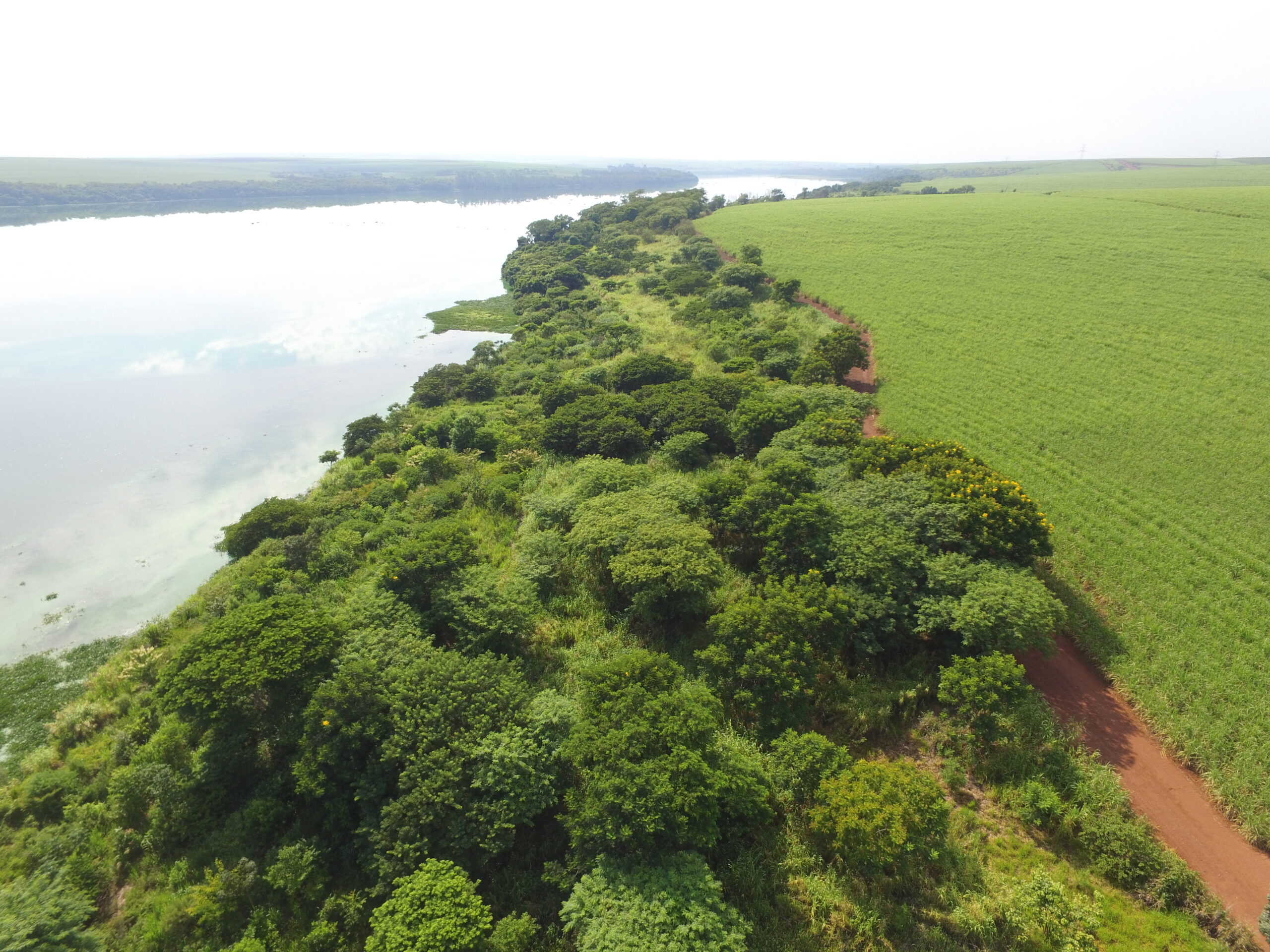
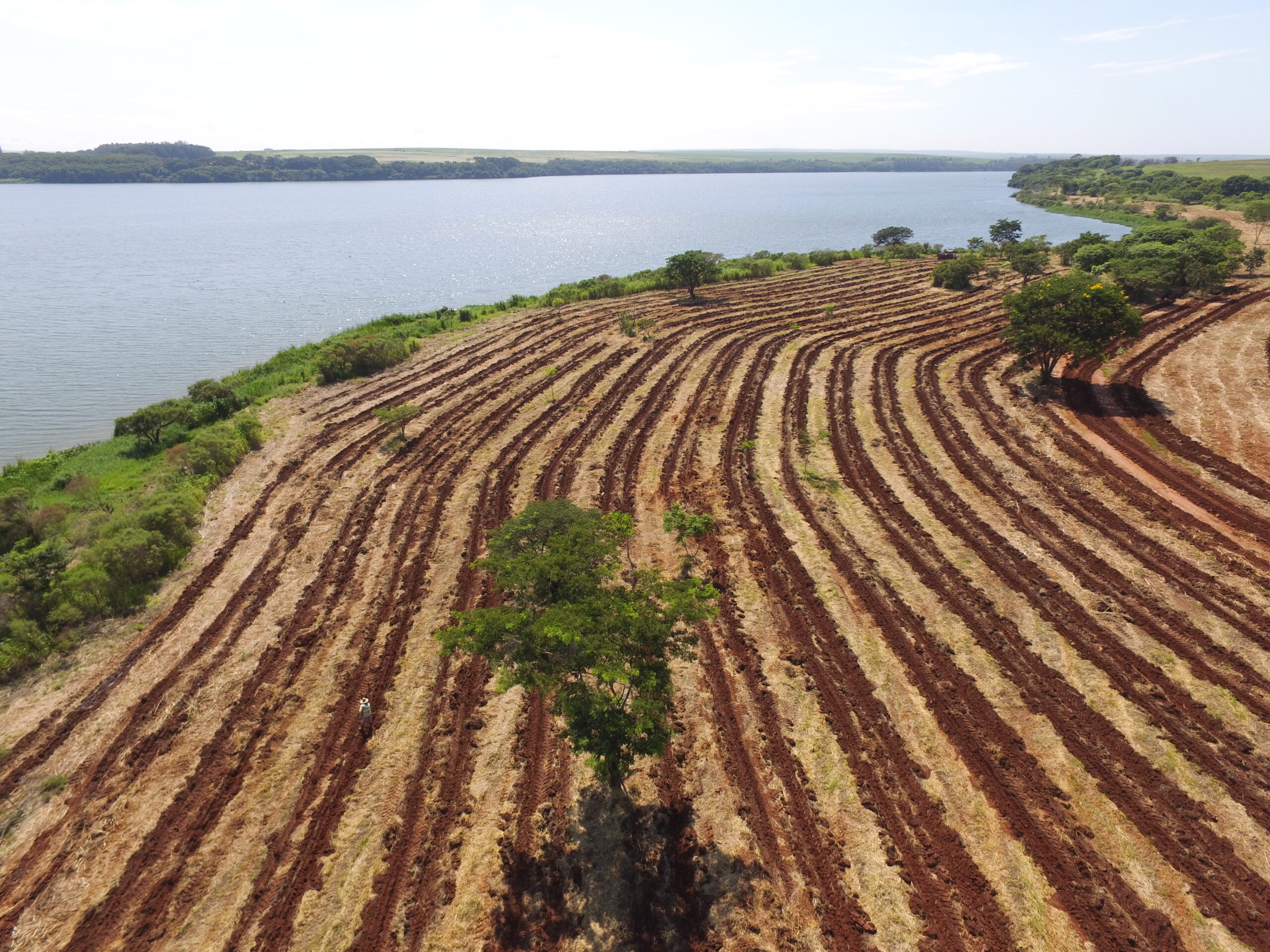
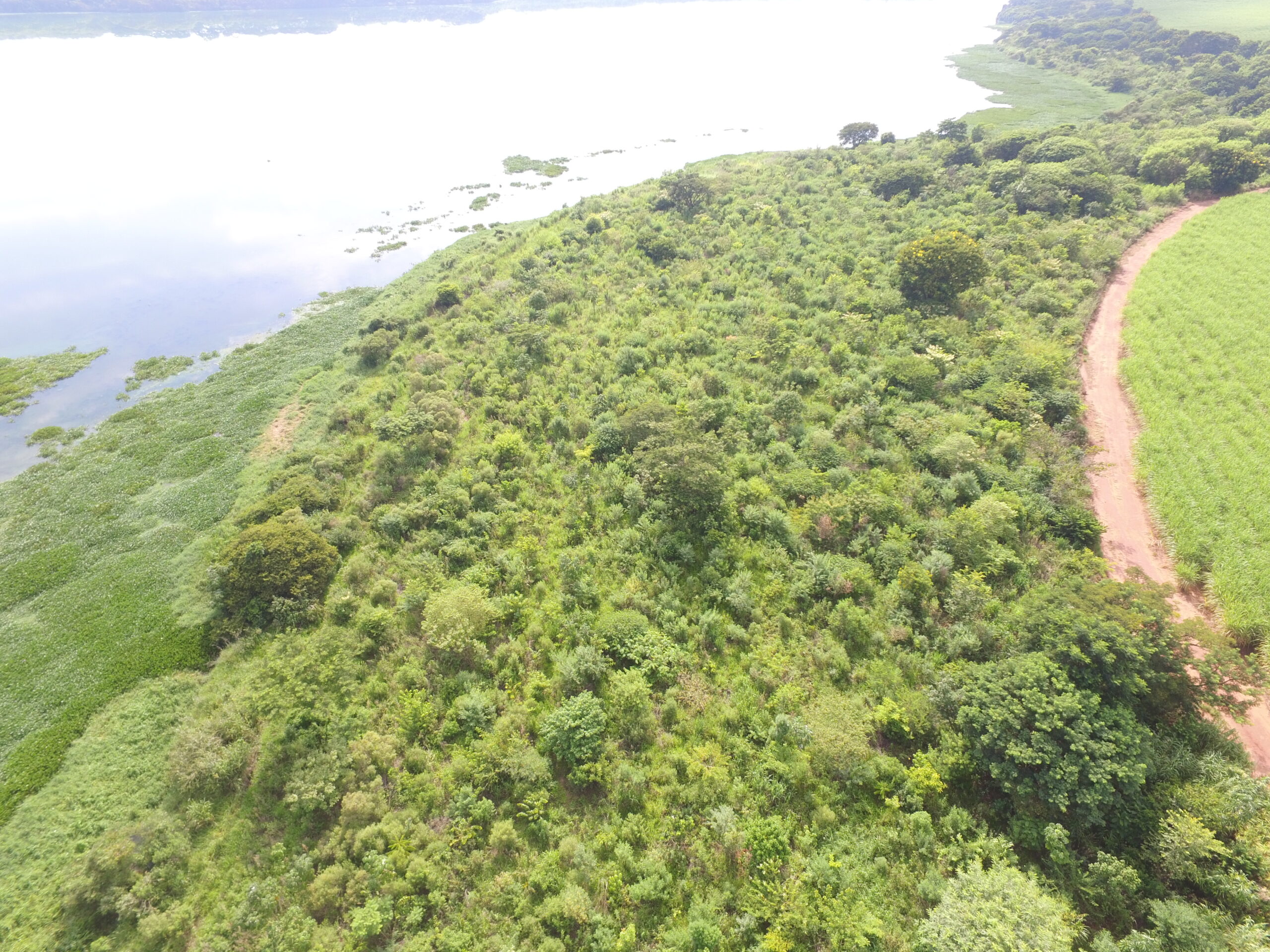
This area is prone to fires in the dry season, which starts in July, and during 2023 several of our restoration areas were affected. A detailed evaluation is being carried out to determine the full extent of the damage now that the rainy season is here, after which we should know if there is any need for replanting.
Another challenge in 2023 were some instances of cattle invasion, despite the efforts and resources invested to fence all restored areas. To avoid such situations, WeForest and partners are discussing and incorporating expert advice to develop a governance strategy to improve AES’s relationship with neighbors and communities surrounding the water bodies we’re restoring.
In June 2023 a field workshop brought together the teams and stakeholders from Pontal and our nearby Tietê Forests project, which we’re running with partner AES Brasil. The aim was to exchange experiences and good practices, and both sides presented their project highlights. The Tietê team was impressed with the size of the restoration sites in Pontal, while the Pontal team was impressed with the complexity of the implementation and maintenance in the Tietê project.
June’s workshop was also a great chance to compare and contrast our two Atlantic Forests projects: they may be just 300 miles apart, but they’re very different! The main similarity is that many of the same species are planted in both projects since they’re located within the same biome. The table below contrasts some of the other aspects of the two projects.
Pontal | Tietê |
|---|---|
Large continuous areas being restored | Small, spread out sites being restored along water courses |
Large forest fragments of forest in the landscape | Highly fragmented and small-sized forest fragments in the landscape |
Long-term presence (IPÊ in Pontal for over 30 years) | Ceiba and AES are private companies with limited time in the region |
Semi-mechanized planting using “matracas” | Mechanized land preparation, manual planting due to size of seedlings |
Hydrogel for irrigation and planting | Hydrogel planting |
No planting fertilization | Planting fertilization |
Planting throughout the year, with support from irrigation | Planting only during the rainy season |
No use of green manure | Use of green manure |
Spacing 2.5 x 2 m | Different planting designs aiming to optimize vegetation development and maintenance activities, resulting in a reduced herbicide approach |
No fertilization post-planting | Fertilization post-planting (once a year for 2 years) |
Community nurseries (on average 400,000 seedlings per nursery per year) | One nursery with complex infrastructure and over 1 million seedlings/year |
Difficult to standardize seedling quality | More technical and standardized production
|
Nursery best practices based on continuous development
| Nursery best practices based on scientific evidence
|
With knowledge exchange workshops like this, WeForest is working towards a much broader goal: to improve technical capacity and project quality to benefit all our restoration activities across the world.
WeForest at SER2023 in Darwin, Australia
In September Natalia Guerin, WeForest’s Country Manager for Brazil, and our partners AES Brasil shared some insights into our Tietê Forests project at the 10th World Conference on Ecological Restoration (SER 2023) in Darwin, Australia. The theme was “Nature and people as one: celebrating and restoring connection”. Being part of this important forum for the movement is testament to WeForest’s dedication to knowledge sharing and being at the forefront of promoting research and best practices in restoration.
Agroforestry – the incorporation of trees and shrubs into agriculture – is a way for smallholder farmers to increase their crop yields while natural resources such as soil and water are improved by the presence of the trees, which also sequester carbon as they grow.
Our pilot agroforestry programme with small farmers from Dandara Rural Settlement had a very successful launch in 2022, with the final numbers being 19 families devoting 12.2 ha (an average of approx. 0.65 ha per family) to agroforestry: in this case, native trees and fruit species combined with cash crops such as cassava, maize and vegetables. Another 1.3 ha was planted during the rainy season in January 2024, increasing the agroforestry of two farmers with silvopastoral systems, and a further 0.5 ha will be planted at the end of 2024.
The agroforestry component has seen two new partners come on board. Most of our farmers are members of the women-led COPROCAM cooperative, who already have a market chain established to sell their products, supporting each other in all aspects of production and marketing. Secondly, a team from NACE-Pteca holds engagement workshops in Dandara every two months and supports post-planting activities, which are often the most difficult to keep up. An agroforestry system requires lots of pruning to keep the system healthy and productive.
2023 started with a workshop to evaluate the first year of activities in Dandara Rural Settlement. It took place at AES Brasil’s nursery in Promissão and was led by Fabio Frattini from NACE-Pteca. Feedback from the farmers was overwhelmingly positive; they are very engaged and excited about the development of the project. COPROCAM suggested setting up a group to support the management of the agroforestry systems, especially for the older farmers, and this approach was set up and tested during the rest of 2023. A complete report on the workshop will be provided by NACE-Pteca.
On March 2nd, the day after the workshop, the farmers planted seedlings in COPROCAM’s common area and shared lunch to celebrate the project’s development. As well as promoting interactions amongst all executive partners (AES Brasil, CEIBA, COPROCAM, NACE-Pteca), the workshop demonstrated the effort and dedication of the Tietê project to engage and empower the community here.
A bumper harvest for Silvia and Cicera!
The farmers enjoyed their very first agroforestry harvest during 2023! Silvia, pictured here with her mother Cícera, has been nurturing pumpkins, green beans and peppers since she established her half-hectare agroforestry system back in December 2022, alongside fruit and native tree species. She shared her pumpkins with her neighbours, ensuring her family gets their fair share, and even keeping her pigs well-fed – and she also earned BRL 91 (roughly US$19) in local markets from selling 13 kg of veg. This year she’ll expand her pumpkin production, aiming to supply public institutions through a Brazilian policy that supports small farmers by providing food to schools, hospitals and prisons.
During the year, a first monitoring campaign to assess five of the agroforestry systems was carried out by NACE-Pteca and an extension group from ESALQ-University of Sao Paulo (Terra Institute), including training the selected farmers in how to keep detailed notes about activities and crop production. This will help us to evaluate the socio-economic and ecological impact of the agroforestry systems, and a report is expected by mid-2024.
The year ended with a Planting Day organised in December by COPROCAM at neighbouring Reunidas Rural Settlement, which fostered community engagement among the two communities. Farmers shared their perspectives on the significance of restoring riparian sites, highlighting their collective commitment to environmental stewardship, with the 42 participants; these included representatives from key institutions including INCRA (the National Institute of Colonization and Agrarian Reform), ITESP (the São Paulo State Land Institute Foundation), and the Secretary of Agriculture from Promissão.
The event also saw the start of the 2023/2024 planting season, with 7.45 ha of riparian planting in Reunidas.In a touching tribute, the planting site in Reunidas was adorned with a plaque honoring the late Mr. Luiz Ruas da Silva (COPROCAM’s founder). His efforts in initiating conversations with neighbours back in 2016 laid the groundwork for the cooperative’s creation.
Every hectare under restoration is mapped with GPS points to generate polygons (areas on a map) that are assigned to sponsors. Permanent monitoring plots are established in our sites and our forestry and science teams conduct surveys to monitor progress of biomass growth, tree density, survival rate and species diversity, among other indicators. Where social impacts are also critical, we measure socio- economic indicators such as the number of beneficiaries, people trained, and income generated from forest-friendly livelihood activities.
Please visit our What We Do web page for more information.
HQ (BE): WeForest asbl/vzw
Cantersteen 47, 1000 Brussels, Belgium
VAT number BE0826.151.968
Incorporated May 26th 2010
WeForest is a supporting member of:

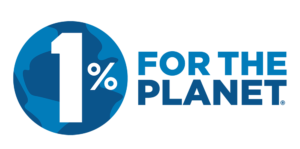


| Cookie | Duration | Description |
|---|---|---|
| __cf_bm | 1 hour | This cookie, set by Cloudflare, is used to support Cloudflare Bot Management. |
| _GRECAPTCHA | 6 months | Google Recaptcha service sets this cookie to identify bots to protect the website against malicious spam attacks. |
| cookielawinfo-checbox-analytics | 11 months | This cookie is set by GDPR Cookie Consent plugin. The cookie is used to store the user consent for the cookies in the category "Analytics". |
| cookielawinfo-checbox-functional | 11 months | The cookie is set by GDPR cookie consent to record the user consent for the cookies in the category "Functional". |
| cookielawinfo-checbox-others | 11 months | This cookie is set by GDPR Cookie Consent plugin. The cookie is used to store the user consent for the cookies in the category "Other. |
| cookielawinfo-checkbox-advertisement | 1 year | Set by the GDPR Cookie Consent plugin, this cookie records the user consent for the cookies in the "Advertisement" category. |
| cookielawinfo-checkbox-necessary | 11 months | This cookie is set by GDPR Cookie Consent plugin. The cookies is used to store the user consent for the cookies in the category "Necessary". |
| cookielawinfo-checkbox-performance | 11 months | This cookie is set by GDPR Cookie Consent plugin. The cookie is used to store the user consent for the cookies in the category "Performance". |
| CookieLawInfoConsent | 1 year | CookieYes sets this cookie to record the default button state of the corresponding category and the status of CCPA. It works only in coordination with the primary cookie. |
| elementor | never | The website's WordPress theme uses this cookie. It allows the website owner to implement or change the website's content in real-time. |
| JSESSIONID | session | New Relic uses this cookie to store a session identifier so that New Relic can monitor session counts for an application. |
| Path | session | Description is currently not available. |
| viewed_cookie_policy | 11 months | The cookie is set by the GDPR Cookie Consent plugin and is used to store whether or not user has consented to the use of cookies. It does not store any personal data. |
| Cookie | Duration | Description |
|---|---|---|
| _hjAbsoluteSessionInProgress | 1 hour | Hotjar sets this cookie to detect a user's first pageview session, which is a True/False flag set by the cookie. |
| _hjIncludedInSessionSample_2773626 | 1 hour | Description is currently not available. |
| aka_debug | session | Vimeo sets this cookie which is essential for the website to play video functionality. |
| authstrategy | session | Description is currently not available. |
| li_gc | 6 months | Linkedin set this cookie for storing visitor's consent regarding using cookies for non-essential purposes. |
| lidc | 1 day | LinkedIn sets the lidc cookie to facilitate data center selection. |
| pll_language | 1 year | Polylang sets this cookie to remember the language the user selects when returning to the website and get the language information when unavailable in another way. |
| UserMatchHistory | 1 month | LinkedIn sets this cookie for LinkedIn Ads ID syncing. |
| Cookie | Duration | Description |
|---|---|---|
| SRM_B | 1 year 24 days | Used by Microsoft Advertising as a unique ID for visitors. |
| Cookie | Duration | Description |
|---|---|---|
| _ga | 1 year 1 month 4 days | Google Analytics sets this cookie to calculate visitor, session and campaign data and track site usage for the site's analytics report. The cookie stores information anonymously and assigns a randomly generated number to recognise unique visitors. |
| _ga_* | 1 year 1 month 4 days | Google Analytics sets this cookie to store and count page views. |
| _gcl_au | 3 months | Google Tag Manager sets the cookie to experiment advertisement efficiency of websites using their services. |
| _hjFirstSeen | 1 hour | Hotjar sets this cookie to identify a new user’s first session. It stores the true/false value, indicating whether it was the first time Hotjar saw this user. |
| _hjSession_* | 1 hour | Hotjar sets this cookie to ensure data from subsequent visits to the same site is attributed to the same user ID, which persists in the Hotjar User ID, which is unique to that site. |
| _hjSessionUser_* | 1 year | Hotjar sets this cookie to ensure data from subsequent visits to the same site is attributed to the same user ID, which persists in the Hotjar User ID, which is unique to that site. |
| ajs_anonymous_id | 1 year | This cookie is set by Segment to count the number of people who visit a certain site by tracking if they have visited before. |
| ajs_group_id | 1 year | This cookie is set by Segment to track visitor usage and events within the website. |
| ajs_user_id | 1 year | This cookie is set by Segment to help track visitor usage, events, target marketing, and also measure application performance and stability. |
| AnalyticsSyncHistory | 1 month | Linkedin set this cookie to store information about the time a sync took place with the lms_analytics cookie. |
| CLID | 1 year | Microsoft Clarity set this cookie to store information about how visitors interact with the website. The cookie helps to provide an analysis report. The data collection includes the number of visitors, where they visit the website, and the pages visited. |
| CONSENT | 2 years | YouTube sets this cookie via embedded YouTube videos and registers anonymous statistical data. |
| MR | 7 days | This cookie, set by Bing, is used to collect user information for analytics purposes. |
| s_vi | 2 years | An Adobe Analytics cookie that uses a unique visitor ID time/date stamp to identify a unique vistor to the website. |
| SM | session | Microsoft Clarity cookie set this cookie for synchronizing the MUID across Microsoft domains. |
| VISITOR_PRIVACY_METADATA | 6 months | Description is currently not available. |
| vuid | 1 year 1 month 4 days | Vimeo installs this cookie to collect tracking information by setting a unique ID to embed videos on the website. |
| Cookie | Duration | Description |
|---|---|---|
| ANONCHK | 10 minutes | The ANONCHK cookie, set by Bing, is used to store a user's session ID and verify ads' clicks on the Bing search engine. The cookie helps in reporting and personalization as well. |
| bcookie | 1 year | LinkedIn sets this cookie from LinkedIn share buttons and ad tags to recognize browser IDs. |
| bscookie | 1 year | LinkedIn sets this cookie to store performed actions on the website. |
| IDE | 1 year 24 days 1 minute | Google DoubleClick IDE cookies store information about how the user uses the website to present them with relevant ads according to the user profile. |
| li_sugr | 3 months | LinkedIn sets this cookie to collect user behaviour data to optimise the website and make advertisements on the website more relevant. |
| muc_ads | 1 year 1 month 4 days | Twitter sets this cookie to collect user behaviour and interaction data to optimize the website. |
| MUID | 1 year 24 days | Bing sets this cookie to recognise unique web browsers visiting Microsoft sites. This cookie is used for advertising, site analytics, and other operations. |
| personalization_id | 1 year 1 month 4 days | Twitter sets this cookie to integrate and share features for social media and also store information about how the user uses the website, for tracking and targeting. |
| test_cookie | 15 minutes | doubleclick.net sets this cookie to determine if the user's browser supports cookies. |
| VISITOR_INFO1_LIVE | 6 months | YouTube sets this cookie to measure bandwidth, determining whether the user gets the new or old player interface. |
| YSC | session | Youtube sets this cookie to track the views of embedded videos on Youtube pages. |
| yt-remote-connected-devices | never | YouTube sets this cookie to store the user's video preferences using embedded YouTube videos. |
| yt-remote-device-id | never | YouTube sets this cookie to store the user's video preferences using embedded YouTube videos. |
| yt.innertube::nextId | never | YouTube sets this cookie to register a unique ID to store data on what videos from YouTube the user has seen. |
| yt.innertube::requests | never | YouTube sets this cookie to register a unique ID to store data on what videos from YouTube the user has seen. |
| Cookie | Duration | Description |
|---|---|---|
| __tld__ | session | Description is currently not available. |
| ajscookies | 1 year | No description available. |
| ajstest | 1 year | No description available. |
| debug | never | No description available. |